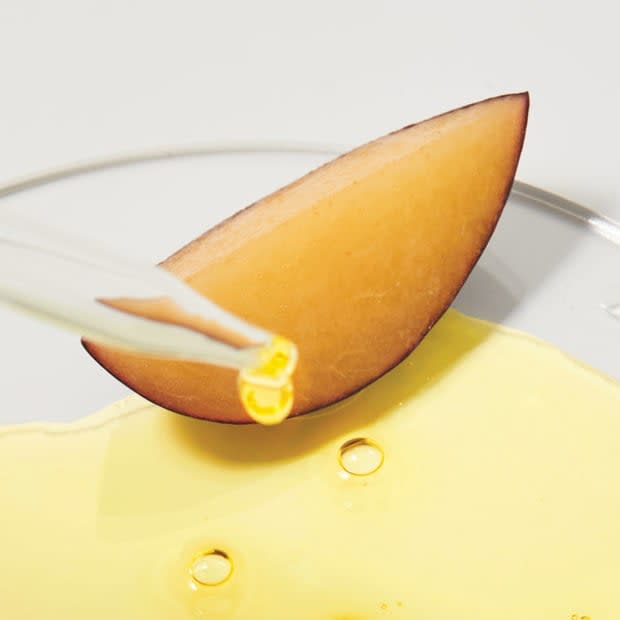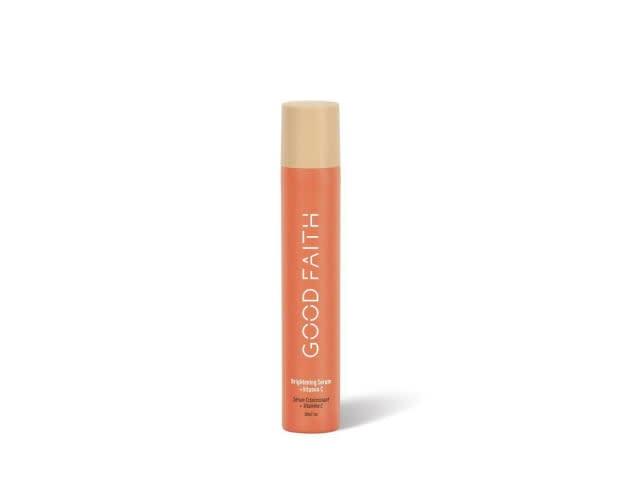The Beauty Industry Is Turning to Upcycled Ingredients to Create More Sustainable Formulas
Trash becomes treasure when discarded byproducts like fruit seeds and pits are given a second life as exfoliators and oils in skin-care products.
The old adage about one person's trash being another's treasure is finding a foothold in the beauty industry of late. As many consumers and retailers demand more sustainable purchasing options, brands are turning to the concept of "upcycling" ingredients as a means of chipping away at the industry's rampant waste problem.
While many beauty companies' initial attempts at fostering sustainability have focused on packaging initiatives (seeking out recycled plastics, plastic alternatives and so on), the practice of upcycling puts a focus on what's going inside the packaging instead. A host of brands looking to prioritize their environmental impact are now relying on a process called upcycling, which takes discarded byproducts like fruit seeds and pits to give them a second life as exfoliators and oils in skin- and personal-care products.
"Upcycled ingredients turn waste materials that would otherwise be headed to the landfill into functional cosmetic ingredients," explains Kelly Dobos, a cosmetic chemist with expertise in skin-care and personal-care product formulation.
Upcycled ingredients — and sustainability overall — are in some ways the next evolution of the "clean" beauty movement. Brands positioning themselves as "clean" (whatever that may mean for their individual purposes) are placing importance on ingredient sourcing, using natural plant-based ingredients from domestic or traceable sources. Brands like Tata Harper and Alpyn Beauty both use all natural farm-grown or wild-harvested ingredients from across the bucolic landscapes of Vermont and Wyoming, respectively. But this seemingly benevolent practice can pose its own potential environmental concerns: The problem lies in that there are only a finite amount of resources in these areas, and the environmental impact of sourcing these raw materials has forced many brands to seek alternatives.
Farmacy, which touts itself as a "farm-to-face" skin-care brand, sources its star ingredients from organic farms in New York, Pennsylvania and around the world. As the brand continues to grow, it's taking steps to minimize its inevitably expanding environmental footprint, and turning to upcycled ingredients has played a big part in that strategy.
"Using upcycled ingredients has become inherently a part of Farmacy's DNA," explains the company's senior director of product development and regulatory, Pamela Marcos. "By the end of 2021, more than half of Farmacy's products contained upcycled ingredients, and we used nearly 1,500 pounds of food that would have ended up in landfills." For 2022, Farmacy has pledged to have 100% of new products utilize upcycled ingredients, which will equate to approximately 2 tons of food waste that would have ended up in landfills, according to Marcos.
Farmacy's recently launched 10% Niacinamide Night Mask, which debuted in January, relies on upcycled blueberry seed oil extracted from the seeds that typically get discarded by the food industry when making jam and candy.
"Upcycling allows us to take the dried seed and turn it into a nutrient-rich oil, full of benefits, including high antioxidants, vitamin E and fatty acids to help protect the skin and skin barrier," says Marcos. "The blueberry seed oil is obtained by utilizing cold press technology, so heat is not introduced to best preserve ingredient potency."
Farmacy will continue to work with farms and suppliers across the globe to source the brand's key ingredients, which helps support farming communities. And by utilizing upcycled ingredients, the brand is also contributing to the development of a more circular economy. This ensures food reaches its highest use and maximizes the return on the resources that have already been exhausted. The brand's plans to expand the use of upcycled ingredients in formulations indicate that this is far more than a passing trend — it may become a core tenent for any brand that claims to be sustainable in the future.
"I think upcycled ingredients really align with what I have heard referred to as 'responsible beauty,' looking deeper into the supply chain at an ingredient's sourcing and sustainability profile, in addition to safety," says Dobos.
"Sustainable," like "clean," is a murky descriptor for beauty products and brands. There's no clear definition, industry-wide standard or regulation for either of these terms, which makes it easy for companies to ultimately spin things and "greenwash" them however they want. But upcycling — which can be clearly defined as putting substances that would otherwise go to waste to use — is, in a sense, greenwashing-proof. The environmental benefits of waste reduction are clear.
Beyond an altruistic desire to put a dent in the beauty industry's waste problem, many brands have also found that turning to upcycled ingredients allows them to deliver formulas that are highly effective and multi-beneficial. Take skin-care brand Le Prunier, for example. It was founded by three sisters who saw opportunity in the plum kernels that had previously gone to waste on their family farm. Le Prunier now formulates its products with 100% upcycled plum kernels, the oil from which is rich in essential fatty acids and powerful antioxidants and offers benefits for skin, hair and nails.

Photo: Courtesy of Le Prunier
The founders discovered that the antioxidant-rich plums actually provide clinically demonstrated skin benefits, along with broad-spectrum sunscreen and blue light protection.
“Our leading patented ingredient, the Plum Superfruit Complex, is primarily made from upcycled plum [byproducts] and actually lends itself to natural SPF protection," says Taylor. "The dried plum was an undiscovered superfruit with inherent skin-care benefits that are now scientifically proven by our clinical studies."
Upon these discoveries, the brand harnessed the power of upcycled plums to develop its second product, Le Prunier Plumscreen, a broad spectrum made from the upcycled plum kernels and non-nano zinc oxide.
"There's really no down side," says Le Prunier co-founder Allison Taylor of the brand's hero upcycled ingredient. "Due to the volume of plums that are grown on our farm, it's unlikely that we'll run into a shortage of ingredients."
While that may be true for a brand sourcing its upcycled ingredients from its own family farm, things are a bit more complicated for larger companies looking to really scale the concept.
"There can be challenges in ensuring quality and consistency needed for cosmetic formulation, like ensuring some materials meet microbiological specifications," notes Dobos. "There's still a bit of [difficulty] to meet the demands of large, mass market brands with upcycled ingredients with consistent quality and sufficient quantities of these types of ingredients."
Alexandra Keating, the founder and CEO of the new personal care brand Uni, knows this all too well. Although Uni's products are geared toward hair and body (there's a shampoo, a conditioner, a body wash, a body serum and a hand soap), the brand works with skin-care chemists to develop its formulas, and has positioned itself as a maker of "skin-care for the body." Uni's hand soap uses upcycled olive pits as an exfoliant, the development of which, Keating says, was a complicated and expensive process.
“Because these ingredients aren't readily available or known, you're bringing in a lot of new elements," explains Keating. "A lot of the issues that I had were with processing, stability and scent. These are all things that usually a lab would know about an ingredient, but because you're bringing in something foreign, you're having to learn as you go.”

Photo: Courtesy of Uni
For Keating, the process was worth it, but she believes not every brand will have the development time and capital necessary in order to cultivate these old-to-new ingredients. She sees upcycling as one element of sustainability, and also one that creates a halo effect inspiring consumers to think more critically and question where their beauty ingredients come from.
"I really love the narrative of getting people to understand what's in their product," says Keating. "It's a way for people to connect that there should be more natural elements in [your] skin and body products. It's creating a good consumer behavior to question ingredients, and I think that's a very positive thing."
Good Faith is another skin-care brand exploring the use of upcycled ingredients in its products. The brand utilizes upcycled grapeseed oil derived from wine production in its Brightening Serum + Vitamin C Serum. Michelle Fry, the company's co-founder, predicts that the use of upcycled ingredients in beauty products will soon go mainstream across the industry.
"We're definitely going to see more upcycled ingredients in beauty, especially as brands explore new ways to be sustainable," says Fry. "It's not enough to make 'clean' or 'natural' claims; brands are being held accountable for their impact on the environment. True sustainability has to apply to more than just packaging, and thankfully, many brands like Good Faith are beginning to push raw material suppliers to make this the standard."
As with any new movement in beauty, the industry is racing to develop standards and practices for regulating upcycled beauty. And it takes time for these measures to catch up with the innovation.
"The Upcycled Food Association is refining an ingredient certification process that also ensures that the supply chain of ingredients doesn't inadvertently diminish environmental benefits during processing," notes Dobos. "Whether this or other certifications rise to the top, these types of programs may help consumers more easily identify products with upcycled ingredients."
While innovations around upcycled beauty may be new, the idea itself is actually quite old. Indigenous tribes practiced recycling and upcycling out of necessity. Indigenous peoples, it has famously been said, had a use for 'every part of the buffalo,' but less famously, indigenous tribes in Pennsylvania were also the first to refine and process petroleum jelly from oil seeps in the ground, using it as a moisturizing salve to protect their wounds and remedy various skin conditions.
So while it's easy to get caught up in the flashy excitement of tech innovation and futuristic biotechnology as methods for advancing the beauty industry, the past can also inspire important progress. History is rife with centuries-old knowledge and cultural practices that offer true gems we can continue to learn from as we look toward the future. As it turns out, solutions to some of our most plaguing problems may be hiding in places most of us wouldn't think to look — even in the trash.

Good Faith Brightening Serum + Vitamin C, $28, available here.
View the 13 images of this gallery on the original article
Please note: Occasionally, we use affiliate links on our site. This in no way affects our editorial decision-making.
Never miss the latest fashion industry news. Sign up for the Fashionista daily newsletter.
